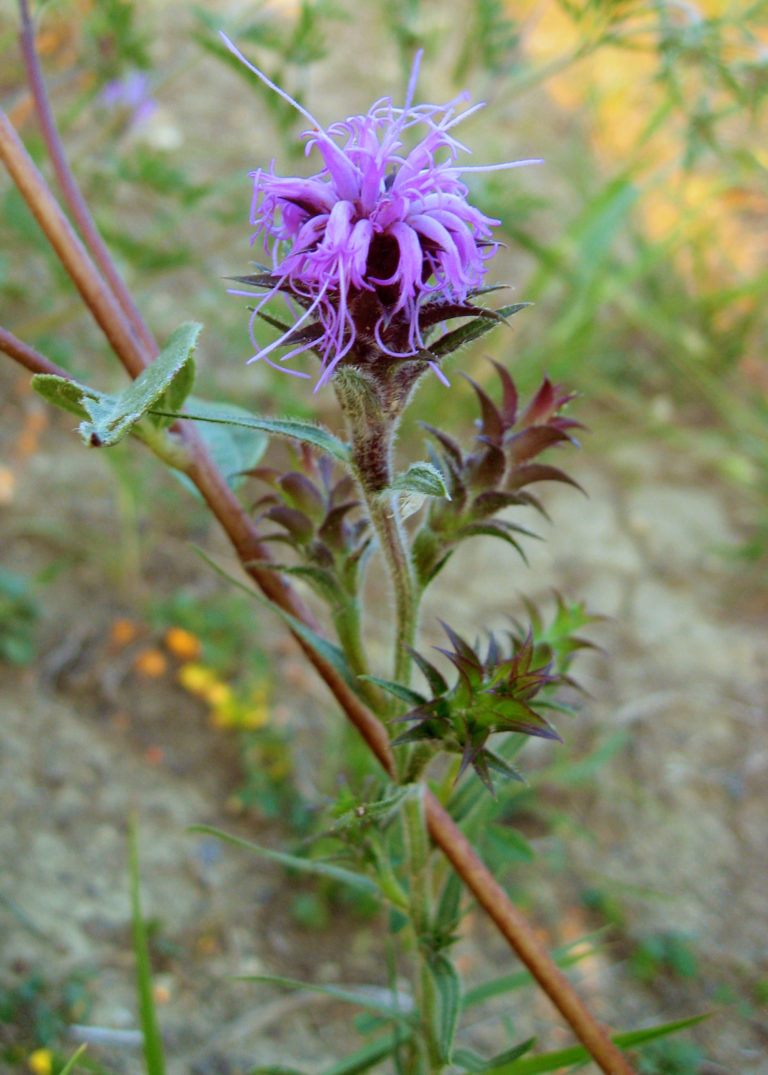Scaly Blazing Star is un upright herbaceous perennial found in high quality natural habitats including openings in upland rocky woodlands, dry ditches and and barren savannas from the eastern Great Plains eastward to Virginia and south. In NC it is reported mostly in piedmont counties. Scaly Blazing Star is one funky flower! “Dr. Seuss” flowers! The plant is only 2 – 2.5 feet high, with sturdy, unbranched shoots supporting the striking inflorescence. Individual flower heads, which are spaced along a terminal spike, are composed of tubular disk flowers (ray flowers are absent) with exserted styles, making for a tufted look. The overlapping bracts just beneath the flower are strongly reflexed and definitely part of the flower’s charm. Planted in a dry site in full sun, Scaly Blazing Star will show off its hard-to-describe rosie-pink-purple color while it attracts hummingbirds, buttterflies, bees and other pollinating insects to your garden.
NURSERY HOURS
Wednesday: 10-4 Thursday: 10-6 Friday-Saturday: 10-4 Sunday: 12-4
Liatris squarrosa

Key Info
Scientific Name: Liatris squarrosa (L.) Michx.
Common Names: Scaly Blazing Star, Scaly Gayfeather, Scaly Liatris
Family Names: Asteraceae (Composite, or Daisy Family)
Plant Type: Herbaceous perennial
Light Requirement: Full sun
Leaf Retention: Evergreen in southern parts of its range
Flower Color: Pinkish violet
Special Characteristics: Tolerates drought, Attracts bees, Attracts butterflies, Attracts Hummingbirds, Good cut flowers
Additional Info
Habit: Erect herbaceous perennial with one to several upright, unbranched stems, (no basal rosette) and needle-like leaves. The central stem is light green, slightly ridged, and glabrous to hairy. The root system consists of a spherical corm with fibrous roots below. Sometimes vegetative offsets are produced.
Height: 2'
Spread: 1'
Soil Conditions: Dry-mesic to dry; acid to neutral pH; average, poor, rocky or sandy soils,
Leaves: The alternate, needle-like, sessile leaves, glabrous or with short hairs, are spaced along the the stem in widely spreading "pseudo-whorls". The lowest leaves are 4-6" long and about ¼" across, becoming gradually smaller ascending the stem.
Flowers (or reproductive structures: Tuft-like, red-violet flower heads, are few in number, and spaced in a terminal spike or narrow raceme 2 to 8 inches long. Each flat-topped flowerhead is about ½–1" across, consisting of 15-45 pink, tubular disk florets (with exerted style) above and overlapping floral bracts (phyllaries) below. There are no ray florets. The prominent scaly bracts are green, relatively numerous and large in size, strongly recurved. The flowerheads are either sessile (or nearly so), or they can have peduncles up to 1¼" long.
Fruit: The disk florets develop into small achenes that are bullet-shaped and pubescent with a tuft of feathery bristles at its apex. The achenes are distributed by the wind to some extent.
Natural Distribution: sandy prairies, thin woods often found in dry or rocky areas of native prairie and savanna vegetation Habitats include hill prairies, limestone or sandstone glades, ledges of sunny cliffs, openings in upland rocky woodlands, and barren savannas. This wildflower is found in high quality natural areas.
USDA Hardiness Zone: 4 to 6
USDA Wetland Indicator Status in NC: Not available
Pollination: Pollinated primarily by bumblebees, butterflies, and skippers
Wildlife Connections: Caterpillars of Blazingstar Flower Moth feed on the florets and developing seeds; the caterpillars of Blazingstar Borer Moth and Liatris Borer Moth bore through the stems; and several aphids suck plant juices. The foliage and flowerheads of Blazingstars are edible to many mammalian herbivores, including cattle, horses, sheep, goats, deer, rabbits, and groundhogs. (Illinoiswildflowers.info)
Propagation: By seeds, stratification required.
